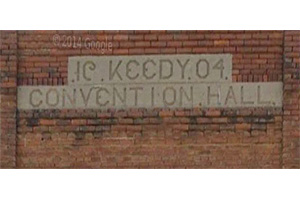
 |
 |
|||||||||||||||||||||||||||||||||||||
Motto: "City of Action." Eleven thousand souls. When you see something like . . .
. . . you figure that there was a fire. Right? Some calamity took the building but spared the tower, and it stands to this day as a momument. Well.
Seems like an awful lot of tower.
It's on the Historic Register, but fat lot of good that seems to do.
If you can't read the carving over the door, it says YMCA. Built in 1913.
Symbols of past prosperity are everywhere. The population peaked at about 25L as late as 1970, but downtown's glories, as usual, were built in the first third of te 20th century. The
It wasn't always a museum, of course. It was the Post Ofice, built in 1909. It's a unique design; corner entrances weren't that popular. It's like they wanted to build in a choke-point in case the locals got restless and decided to storm all public buildings.
A ghost ad. The whole wall was covered. I've deduded that the big word is MOORE'S.
Annnnd here's how I deduced it!
The building was originally called "The Emporium." The second-story details are still intact, but it was stupidly scoured on the ground floor, and the windows were given those preposterous shrouds. At the time of this picture, it was a night club.
A pristine Beaux-Art building, ruinated for your legal convenience:
I know that doesn't mean anything, but neither does this.
What kind of clothing? Werelads?
It looks as if it was revealed when something next door went down. Signs don't stay that fresh when lashed by the elements for 60 years.
A handsome upper story, and an empty and bereft first floor:
Looks like a late-30s, early-40s renovation. It's always sad when the facade falls off and you see old, rotten boards. No one cares, it what that says. Can't quite figure out the bricks on the right side - they're part of the structure, but were they meant to tie it to a building that was once next door?
Trees! That'll bring downtown back. Trees.
The empty boxes held letters, of course - and something about this suggests that the trees went in when the letters had been gone for some time. No store owner would want his sign obscured like this.
Another late-30s/ early-40s renovation:
The glass (or Vitrolite) panels have fallen off, leaving exposed the daubs of glue. Someone's handiwork. Wonder if he was around to see them in the light of day again.
The upper story in so many small towns is another world, a quiet one, an old one, divorced from the bustle and styles of the day . . .
. . . and this division persists long after the bustle subsides for good.
Finally, a bit of Buckaroo Revival: shingles SHINGLES instead of the big broad windows. Easy terms at Crook's! It's the building in the picture with the missing letters.
You can see what's inside the Crook Building here. It's like going to Pompeii. More next week; it's a two-entry town. |
||||||||||||||||||||||||||||||||||||||
 |
 What did they used to make? That's the question I always ask. What was it, once?
What did they used to make? That's the question I always ask. What was it, once?



























